I feed my Venus flytraps frequently to supplement their nutrition. As a beginner, I struggled to find appropriate food sources. I knew Venus flytraps ate live flies and other insects, but what about dead bugs?
Venus flytraps can consume dead flies; flies are a good source of nutrients. However, the plant won’t start digesting a dead insect automatically. They must receive further stimuli to trick the plant into digesting a dead bug.
Dead flies are a good food option for Venus flytrap. But, feeding the plant dead insects requires some extra steps. In this article, you will learn all the feeding steps and some tricks.
Can Venus Flytrap Eat Dead Flies?
Venus flytraps consume various insects, such as ants, flies, beetles, slugs, grasshoppers, and gnats. In the wild, they capture them live and digest them. At home, they can also capture live bugs, especially when living outdoors.
Indoor Venus flytraps sometimes need some help with the feeding process. They might capture prey now and then, but their success depends on the supply of bugs. Venus flytrap owners usually feed their plants manually when the plants cannot capture bugs on their own.
You can safely feed dead flies to a Venus flytrap. Flies are suitable food for Venus flytraps. They are small enough to fit inside most adult traps, they have soft tissue, and they are readily available.
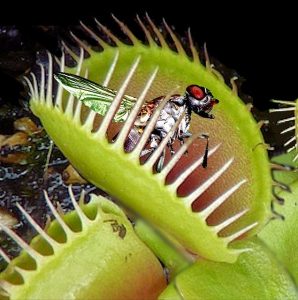
Feeding live bugs to a Venus flytrap is challenging. You must capture or obtain the bug. Then you need to feel comfortable holding the bug. And finally, you must dominate the bug to carefully and accurately place it inside your plant’s traps. Employing dead bugs is an alternate solution that can be equally effective if you follow the correct procedure.
How to Feed Dead Flies to Venus Flytraps
Venus flytraps are designed to consume live bugs. But, with some extra steps, you can successfully feed dead bugs to a Venus flytrap.
First things first, you must learn about the feeding process and trigger hair stimulation.
The traps of a Venus flytrap are made up of two lobes. Inside each of the lobes, there are trigger hairs. Those trigger hairs are thin filaments that are attentively waiting for some form of stimuli. If something comes in contact with the trigger hairs and touches them twice within a few seconds, an electrical signal is sent. That electrical pulse sends a specific signal which triggers the lobes to close.
The picture below shows an open trap. The trap exhibits three trigger hairs in each lobe.
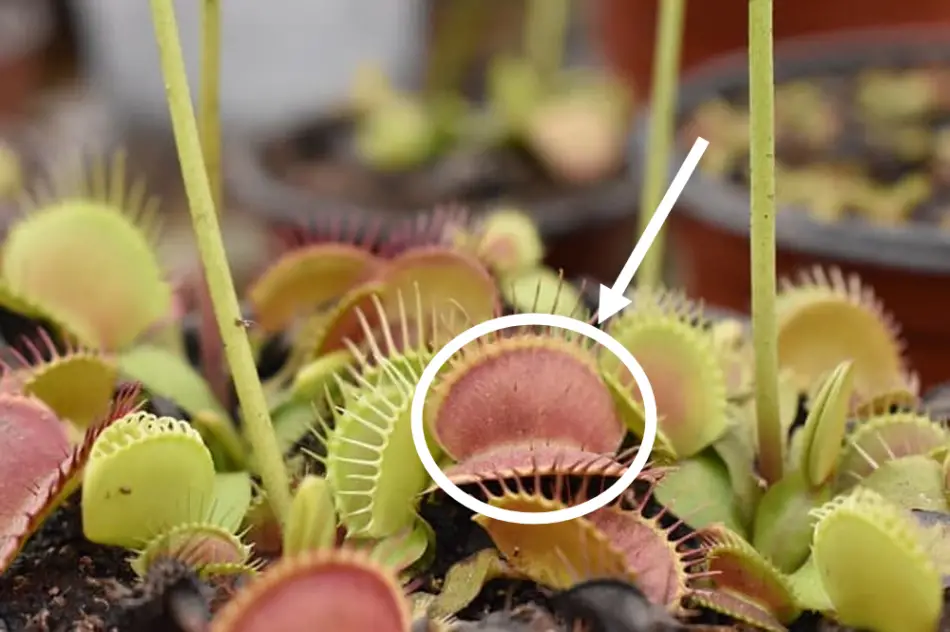
After the appropriate stimuli, the traps close (hopefully enclosing prey). But the lobes do not close shut completely. First, they go into a semi-close stage. The cilia surrounding the leaves prevents the bug from escaping. The plant only closed shut if it receives further stimuli. When a bug finds itself trapped inside a Venus flytrap, it will try to escape. The bug moving and running inside the trap creates further stimuli. Such additional stimuli prompt the plant to close completely and start producing digestive enzymes.
When feeding dead prey to a Venus flytrap, you must ensure stimulating the trigger hairs for the trap to close. And then, provide further stimuli to prompt the plant to start producing digestive fluids.
Now, here are the instructions to feed dead flies to your Venus flytrap:
- Select the fly: Make sure the bug is small enough to fit inside the trap you intend to feed. A good rule of thumb is to select a fly that is 1/3 of the size of the leaf or smaller. Also, you must make sure the dead fly is in a good state. Make sure the dead bug does not have any mold growing or fungus.
- Spot the trigger hairs: Look carefully at the trap and detect the trigger hairs. Depending on your plant’s size and color, you might spot them with your bare eyes or need a magnifying glass.
- Grab the dead fly with your hands or a tool: You can employ chopsticks or a tweezer to hold the bug.
- Place the bug inside the trap and stimulate: After grabbing the insect, you must place it inside the traps. Attempt to place the bug in the center of the trap. After placing the bug in the trap, you can use your fingers or your tool to stimulate the trigger hairs. Softly touch a couple of the trigger hairs until the trap closes. Be attentive and make sure you remove your fingers and any tool fast enough to let the lobes close.
- Stimulate further: Now, you must provide further stimuli to trick the plant into producing digestive fluids. Use your fingers or a soft tool to touch the outside of the trap. Softly grab the trap from both sides and tap. Tap the sides again and again for 30 seconds to 1 minute. The lobes should close completely by the end of this step. The photo below illustrates the concept. I use wooden chopsticks to tap the lobes of my plant during feeding.

After feeding your Venus flytrap, the trap will remain closed for several days or even weeks. The digestion process is slow. Monitor the leaf during the process. If the leaf starts withering, try using a smaller bug next time.
After extracting nutrients from the bug’s soft tissue, the plant will reopen and expose the left-over parts of the bug.
Venus Flytrap Feeding Basics and Tips
You have learned how to feed your plant dead flies and dead insects in general. But, it would help if you learned the basics of the feeding process. Feeding Venus flytraps incorrectly can waists the plant’s energy and make them lose leaves.
I wrote a complete guide on how to feed Venus flytraps . Make sure to review it before feeding your plant. It not only outlines the process, but it compares different feed options.
. Make sure to review it before feeding your plant. It not only outlines the process, but it compares different feed options.
Here is a summary of some feeding basics and some tips:
- Only feed one trap at a time. A single bug is enough to feed the whole plant.
- Avoid overfeeding by only feeding the plant once every 4-6 weeks.
- Carefully select the size of the trap. Venus flytraps lose leaves when they attempt to consume large bugs. Select prey that is 1/3 of the size of the trap or smaller.
- Venus flytraps living outdoors do not need to be fed. They can capture their own prey.
- During winter dormancy, there is no need to feed Venus flytraps. Feeding them can actually hurt the plant.
- When employing live prey, you can stunt the bug by placing it in the fridge for a few minutes.
- Venus flytraps do not need insects to survive. They can survive solely with the photosynthesis. Plants that have access to prey develop and grow at a faster rate.
Other Food Options Beyond Flies for Venus Flytraps
Against popular belief, Venus flytraps can consume a wide variety of insects, not only flies. Flies are a fair choice when selecting food for Venus flytraps. But some insects might be better options.
Mealworms, bloodworms, and crickets are very nutritious and effective prey options for Venus flytraps. All three options are sold in pet stores for $5 to $12. And they can be stored for long periods.
You do not always have to capture insects to feed your plant. Buying the bugs is also an option. Most pet stores that offer supplies for reptiles and fish carry freeze-dried mealworms, bloodworms, and crickets. All three options are nutritious and inexpensive. Take a trip to Petco or PetSmart and grab a bottle of dried up insects.
The process of feeding dried up insects is the same as feeding dead flies. The only difference comes when preparing the bug. You must rehydrate the bug before feeding it to your plant. Just add a few droplets of distilled water on top of the insect. Then, let it stand for a few minutes before feeding. The dead bug will absorb the water and rehydrate itself.
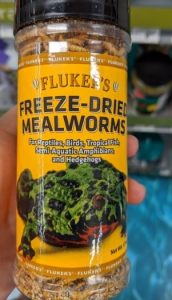
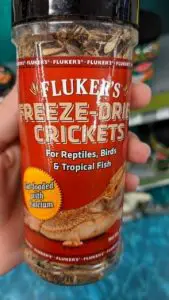
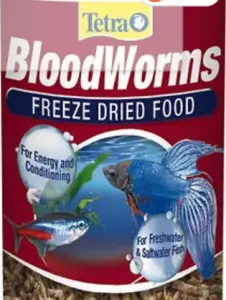
For more food option ideas, visit this article: Venus Flytrap Food Options . It gives you a list of common Venus flytrap food options and highlights the best.
. It gives you a list of common Venus flytrap food options and highlights the best.
Recommended Products for Growing Carnivorous Plants
Finding the best pots, lights, and soil for carnivorous plants is difficult. I have grown carnivorous plants for over 5 years, and these are the products I use. The links will take you to Amazon to view the prices and full specs:
- Carnivorous Plant Soil
- Carnivorous plant soil: https://amzn.to/422yLZa

- Carnivorous plant soil: https://amzn.to/422yLZa
- Artificial Lighting
- Small plant light for 1-2 plants: https://amzn.to/3oQsmSj

- T8 LED light fixture for multiple plants (6500k Cool White): https://amzn.to/3uWoeh2

- Small plant light for 1-2 plants: https://amzn.to/3oQsmSj
- Pots and Miscellaneus
- Nursery pots for single plants: https://amzn.to/3oL8YGq

- Nursery pots for single plants: https://amzn.to/3oL8YGq
- TDS meter to measure water quality: https://amzn.to/3g8VKLI

- Dried crickets to feed carnivorous plants: https://amzn.to/34QEnKv

